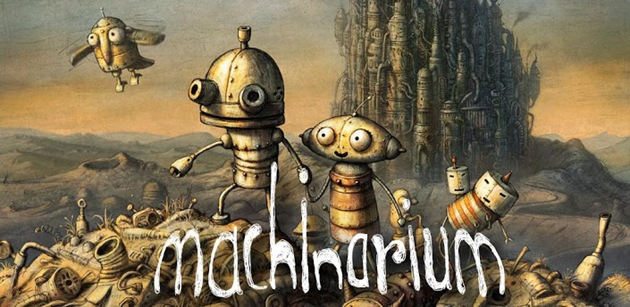Albrecht Durer was born in a large family of a jeweler, he had seventeen brothers and sisters. In the XV century, the profession of a jeweler was considered very respectful, so the father tried to teach his children the craft he was engaged in. But Albrecht's talent for art manifested itself at an early age, and his father did not discourage him, on the contrary, at the age of 15 he sent his son to the famous Nuremberg master Michael Wolgemuth. After 4 years of training at the master, Durer went to travel and at the same time wrote his first independent picture "Portrait of the Father".During the trip, he honed his skills from different masters in different cities. Consider the most famous paintings by Albrecht Durer , recognized by the world community.
10
Self-portrait with holly
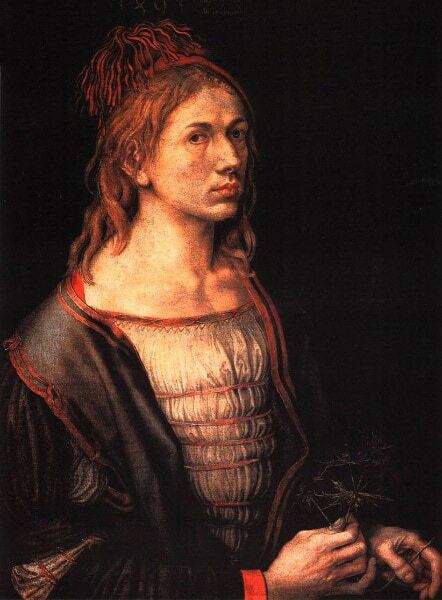
Self-portrait with holly. This painting by Dürer has caused a lot of condemnation, both among the artist's contemporaries, and with contemporary art critics. It's all about the posture in which the author painted himself and the hidden message transmitted through the details. At the time of the artist in full-face or close to this, it was possible to draw only the saints. The holly person in the artist's hand sends a message to the crown of thorns, which was laid on the head of Christ at the crucifixion. The inscription in the upper part of the canvas says "My works are determined from above," this is a reference to the devotion of the author to God, and that all his achievements, at this stage of life with the blessing of the Lord. This picture, stored in the Louvre, is estimated as having made certain changes in the human worldview.
9
Self-portrait of Durer in adulthood

Self-portrait of Dürer in adulthood. With age, Durer went even further in reflecting his experiences on canvas. For this impudence contemporaries severely criticized the artist. On this canvas he painted his self-portrait in full-face. Whereas even more recognized contemporaries could not afford such insolence. In the portrait, the author looks strictly in front of him and holds his hand in the middle of the chest, which is typical of the reflections of Christ. Ill-wishers found in Durer's painting all the similarities and reproached him in comparing himself with Christ. Considering the picture, someone can agree with the critics, and someone to see, something more. There are no objects attracting attention to the picture, which makes the contemplator concentrate on the image of a person. Those who saw the picture, consider the range of feelings on the face and image of the person depicted.
8
Portrait of a Venetian woman

Portrait of a Venetian woman. The portrait, painted in 1505, is considered a Venetian directed work by Durer. It was during this period that he stayed for the second time in Venice and honed the skill of Giovanni Bellini, with whom he eventually became friends. Who is portrayed in the portrait is not known to some suggest that this is a Venetian courtesan. Since there is no information about the marriage of the artist, other versions about the person of the person who did not pose. The painting is kept by the Vienna Museum of Art and History.
7
Martyrdom of ten thousand Christians
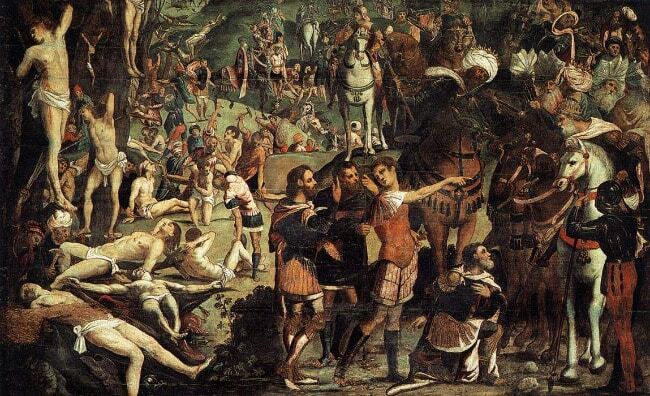
Martyrdom of ten thousand Christians. The painting was commissioned by the patron of Durer for the Church of All Saints in Wittenberg. Because of the presence in the church of the relics of some of the martyrs of these ten thousand. Religious history familiar to many believers, about the beating of Christian soldiers on Mount Ararat is reflected in all the details. In the center of the composition, the author painted himself with a flag on which he wrote the time of writing and the author of the picture. Next to him is a friend of Dürer's drawing, the humanist Conrad Celtis, who died without waiting for the end of the picture.
6
Feast of the Rosary

Feast of the beads. The most recognizable painting by Dürer was written for the San Bartolomé Church in Italy. The artist wrote this picture for several years. The picture is saturated with bright colors, as this trend became popular at that time. The picture is named because of the plot reflected in it, the Dominican monks who used rosaries in their prayers. In the center of the picture is the Virgin Mary with the infant Christ in her arms. In the environment, praying, among whom Pope Julian the Second and Emperor Maximilian the first. Baby - Jesus gives out wreaths of roses to all. Dominican monks used rosaries strictly white and red. White symbolizes the joy of the Virgin, the red blood of Christ in the crucifixion.
5
Hands of the Prayer

Hands of the Prayer. Another very famous painting by Durer was copied many times, printed on postcards, stamps and even coins. The history of the picture is striking in its symbolism. On the canvas is depicted, not just the hand of a devout person, but of Durer's brother. Even as a child, the brothers agreed to paint in turn, since fame and wealth from this craft does not come at once and not all, one of the brothers had to ensure the existence of another. The first for painting took Albrecht, and when it was his brother's turn his hands were already out of the habit of painting, he could not write. But Albrecht's brother was a pious and humble man, he did not mind his brother. These hands are also reflected in the picture.
4
Portrait of Maximilian I

Portrait of Maximilian I. Durer portrayed his patron several times in different paintings, but Maximilian's first portrait became one of the world-famous paintings. The emperor depicted, as the monarchs relied, rich apparels, arrogant gaze, and from the picture so arrogant. As in other paintings of the artist there is a kind of symbol. The emperor holds a grenade in his hand, a symbol of abundance and immortality. A hint that it is he who provides people with prosperity and fertility. Seen on a cleaned piece of garnet grain symbol of the multi-faceted personality of the emperor. Knight, Death and the Devil
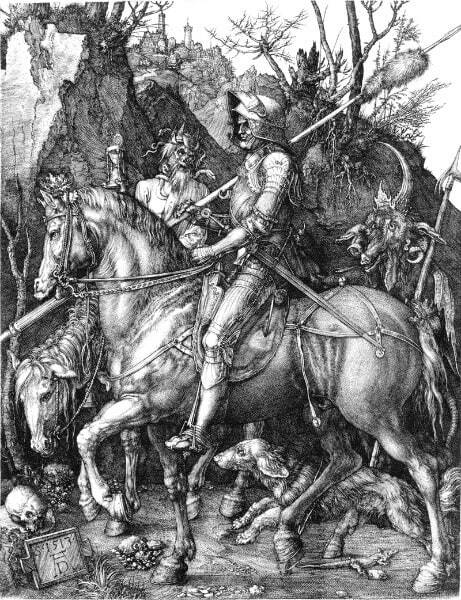
Knight, Death and the Devil. This engraving of Durer symbolizes the path of man in life. A knight in armor is a man protected by his faith from temptations. Going next to death is depicted with a sand clock in hand, indicating the total at the end of the allotted time. The devil walks behind the knight, depicted in the form of some miserable creature, but ready at the slightest opportunity to attack him. All comes down to the eternal struggle between good and evil, the strength of the spirit before temptations.
2
Four horsemen of the Apocalypse
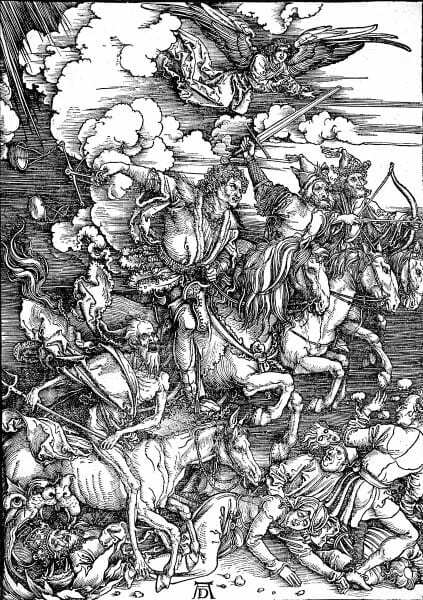
Four horsemen of the Apocalypse. The most famous engraving of Durer from his 15 works on the theme of the Biblical apocalypse. The four horsemen are the Winner, War, Hunger and Death. Following them, hell, on the engraving is depicted in the form of a beast with an open mouth. As in the legend, the horsemen rush, sweeping away everyone on their way, both the poor and the rich, and the kings and common people. A reference to the fact that everyone gets what they deserve, and all will answer for their sins.
1
Adoration of the Magi

Adoration of the Magi. The painting was written during the period of Dürer's return from Italy. In the picture, German attention to details and colors are intertwined, the brightness of colors peculiar to the Italian renaissance. Attention to lines, mechanical subtleties and trivialities makes reference to the sketches of Leonardo da Vinci. In this world known to the world, the scene, described in detail in the Biblical legends, painted in canvas, leaves the impression that it was exactly the way it happened.

